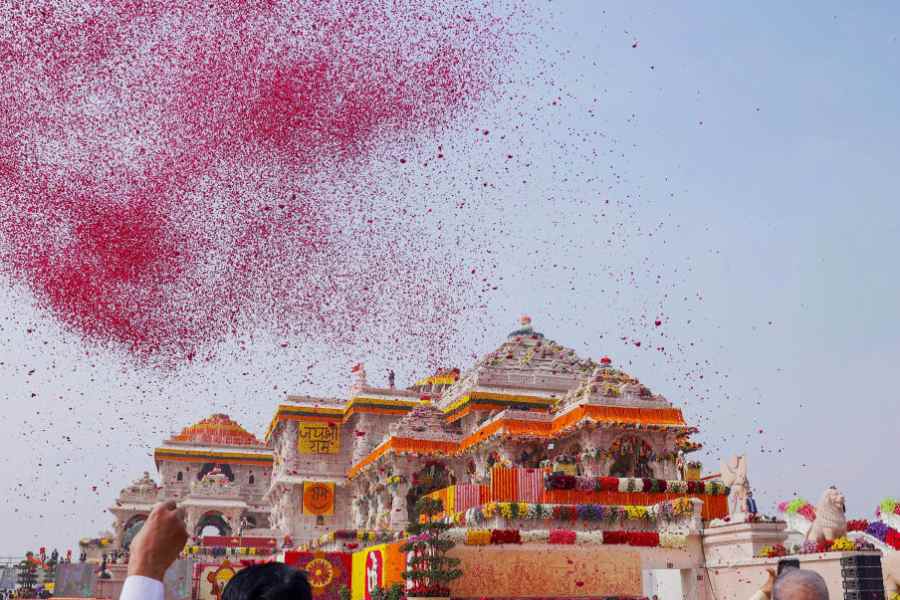Prime Minister Narendra Modi asked critics of the Ayodhya movement and the Ram temple to “introspect” and change their thinking, addressing a VIP gathering after participating in the consecration of the shrine as the chief guest in Ayodhya on Monday.
“The way we have opened the locks of history suggests that our future is going to be more beautiful than the past. There was a time when some people would say a fire would break out if the Ram temple was built,” Modi, who had performed the first aarti before the 4.24ft-tall idol, said.
“Such people don’t understand the sanctity of Indian society. The construction of the temple of Ram Lalla symbolises peace, patience, harmony and coordination.”
He went on: “It is a temple of national awakening in the form of the Ram temple. Ram is the faith of India, the foundation of India/ Ram is the thought of India, the law of India/ Ram is the consciousness of India, the contemplation of India/ Ram is the prestige of India, the might of India/ Ram is the flow, Ram is the influence/ Ram is the norm, Ram is the policy/ Ram is the permanence, Ram is the continuity/ Ram is vast, Ram is expansive/ Ram is all-encompassing, Ram is the universe, the soul of the universe.”
Modi added: “I can see that the construction (of the temple) is producing energy and not fire. The Ram temple has inspired us to take the path to a bright future. I would call on those people (the critics) to come and feel it, introspect about your thinking. Ram is energy and not fire; Ram is a solution and not a dispute; Ram is not only present but also endless.”
Modi said: “A nation stands after discarding the sense of slavery. People will discuss this date even after 1,000 years. It is by the grace of Ram that we are living this moment, we are watching it happen…. I can feel that godly moment…. The godly powers are present around us.”
Modi also said: “While defining ‘Ram’, the rishis have said, ‘Ramayantiswin iti Ramah’, which means that one who is immersed in the Self is Ram. Ram is in everything, from the mind to the mountains and the traditions.
“People have expressed Ram in their own fashion in different ages. And this Ramras (the pleasure of saying ‘Ram’) flows like a continuous life. People from every corner of India have invoked Ramras since ancient times. Ramkatha (the story of Ram’s life) is Shiva and the Ramayan is endless. The ideas of Ram, the values of Ram, the education of Ram are the same everywhere.”
Modi took his seat at the sanctum sanctorum at 12.10pm and all the rituals were over at 1.17pm, which means the temple was officially open to ordinary devotees.
However, the public will be able to offer prayers there only from Tuesday since the premises were on Monday hosting some 8,000 of India’s rich, famous and influential, invited to the event by the temple trust.
The temple stands at the site where a mob of kar sevaks had demolished the Babri Masjid on December 6, a widely condemned incident that led to riots and changed Indian politics in the long run. Many Opposition leaders had declined the invitation to Monday’s consecration accusing the BJP of turning it into a political event.
Modi thanked the judiciary for the Supreme Court’s November 2019 verdict that handed the site to Hindus to build the temple. The court had, however, denounced the Babri demolition.
The Prime Minister appeared to be arguing that the Ayodhya movement and the construction of the temple were mandated by the Constitution.
“Lord Ram is present in the first copy of India’s Constitution. The legal battle continued for decades even after the Constitution was adopted. I thank the judiciary ofIndia, who saved the honour of justice. The temple of Lord Ram was built in accordance with the law,” he said.
A constitutional expert told this newspaper that the first copy of the Constitution of India carried a painting of Ram, Sita and Lakshman at the beginning of the third chapter, which enshrines the fundamental rights of citizens.
Modi said the whole of India, as well as many other countries, was commemorating the day.
The Vishwa Hindu Parishad, which dominates the temple trust, had urged Hindus across the country to celebrate the occasion at temples near their homes. The VHP had distributed puja ingredients at some places.
But in Ayodhya town, all the celebration seemed confined to the main road, Ram Path, where the temple is located. The townspeople have been trying to largely stay indoors since January 14, when the security forces arrived in large numbers and barricaded areas near the temple.
Residents began stepping out of their homes gradually after 6pm on Monday, by when the Prime Minister and most other political heavyweights had left Ayodhya.
“The heat seems to have subsided with the departure of the powerful politicians and the heavy security around them,” Shankar Acharya, a small-time sadhu, said while lounging on a bench outside a closed tea stall on Dant Dhavan Street.
“The dust will settle down after the troops receive their marching orders in the night. The residents of Ayodhya town are heaving a sigh of relief after many days.”
Modi interacted with the workers involved in the temple construction and asked them to speed up the shrine’s completion.










